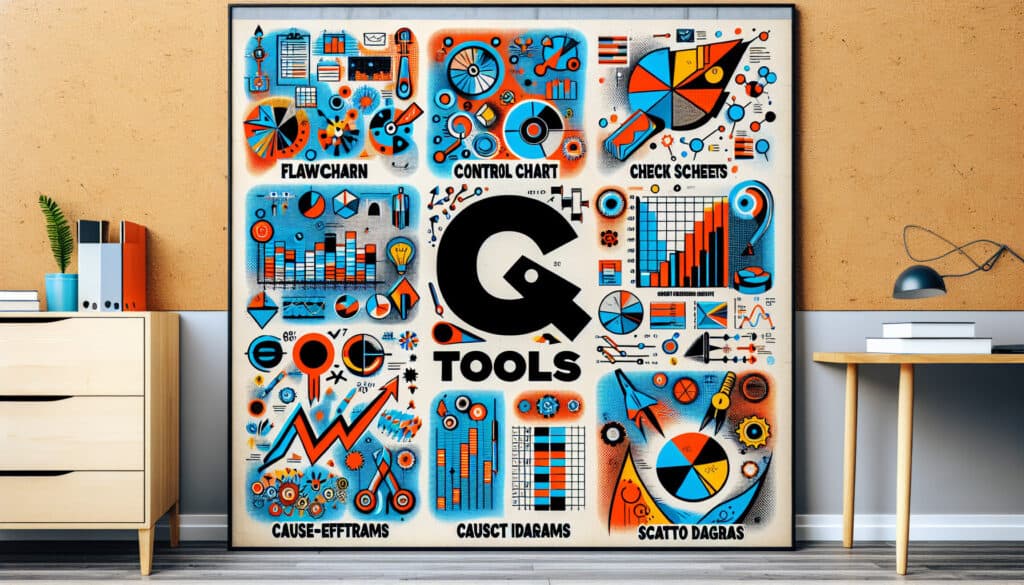一套用于质量控制和改进的基础、图形和统计工具。
- 方法: 客户与营销, 经济学
7 质量控制工具

7 质量控制工具
- 持续改进, 控制图, 帕累托图表, 解决问题的技巧, 流程改进, 质量保证, 质量控制, 质量管理, 质量管理体系(QMS)
目标
如何使用
- 这些工具用于收集、分析和解释数据,以解决与质量有关的问题。它们包括帕累托图表、鱼骨图、控制图和直方图等工具。
优点
- 使用简单,提供了解决问题的结构化方法,有助于以数据为导向进行决策。
缺点
- 可能不足以进行复杂的统计分析,其有效性取决于正确的应用和解释。
类别
- 精益西格玛, 制造业, 解决问题, 质量
最适合:
- 发现并解决生产环境中的大多数质量问题。
7 QC Tools 方法论适用于各行各业,如制造业、医疗保健业和服务业,使团队能够利用实用的数据分析技术,系统地处理和解决质量问题。例如,在制造业中,团队可以运用帕累托图表来识别最常见的缺陷,将工作重点放在影响生产效率的最重要问题上。在头脑风暴会议上,可以利用鱼骨图来揭示质量故障的根本原因,促进包括工程师、质量保证和生产人员在内的跨职能团队协作解决问题。控制图是长期监控流程不可或缺的工具,通过识别可能预示潜在问题的差异,帮助从业人员保持质量标准。直方图分析支持数据分布的可视化,揭示生产一致性的模式和潜在的改进领域。通常,这些方法在项目的质量改进阶段使用,通常由质量经理或团队领导发起,让整个组织的利益相关者参与进来。关于这些工具的培训课程使学员掌握了实时分析质量问题的必要技能,从而能够根据经验证据而不是假设快速做出决策。使用 7 种质量控制工具可以促进持续改进的文化,鼓励开放式沟通,并增强团队对质量改进计划的主人翁意识。
该方法的关键步骤
- 确定要重点解决的质量问题。
- 利用帕累托图表,根据频率或影响确定问题的优先次序。
- 采用鱼骨图分析已发现问题的根本原因。
- 使用散点图来确定变量之间的关系。
- 实施控制图,监控一段时间内的流程性能。
- 创建直方图,直观显示问题相关数据的分布情况。
- 进行故障模式和影响分析 (FMEA),以评估潜在故障。
- 在分析过程中使用核对表收集定性和定量数据。
专业提示
- 将实时数据监控与控制图相结合,可在趋势发展时加以识别,从而实现积极主动的质量管理。
- 利用多维鱼骨图从不同角度剖析根本原因,加强跨职能团队之间的协作分析。
- 将帕累托分析与预测分析相结合,不仅能发现主要问题,还能根据历史数据模式预测未来可能出现的问题。
历史背景
1962
1970
1972
1980
1980
1986
1986
1960
1963
1970
1980
1980
1980
1986
1987
(如果日期不详或不相关,例如 "流体力学",则对其显著出现的时间作了四舍五入的估计)。















相关文章
制造运营管理(MOM)
制造执行系统(MES)
生产控制计划
人工测试
手动搬运评估表 (MAC)
手动任务风险评估工具(ManTRA)